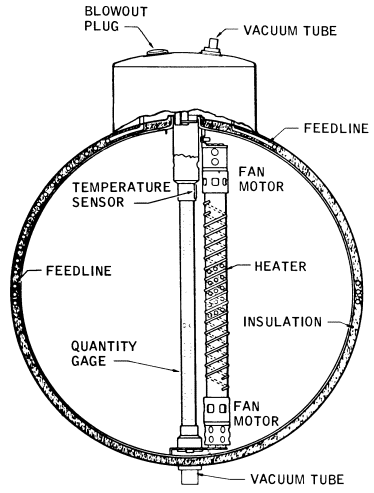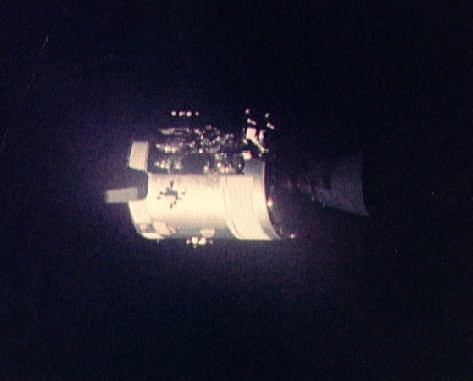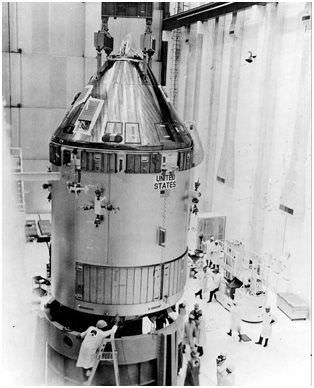[/caption]
Note: To celebrate the 40th anniversary of the Apollo 13 mission, for 13 days, Universe Today will feature “13 Things That Saved Apollo 13,” discussing different turning points of the mission with NASA engineer Jerry Woodfill.
The saga of the Apollo 13 accident actually began years prior to the launch of the mission. As Jim Lovell wrote in his book, “Lost Moon” the accident was “an accumulation of human errors and technical anomalies that doomed Apollo 13.” But had coincidences been just a little different Apollo 13 could have been an accident from which there was no rescue. NASA engineer Jerry Woodfill believes where Tank Two was positioned in the Service Module led to a successful rescue. “I contend that the crew would have died if the flawed O2 Tank Two had not been on the outer perimeter of the Service Module,” Woodfill said. “The position of that tank had much to do with the extent of the explosion’s damage. Had Tank One been damaged, no rescue would have been possible.”

The oxygen tanks were specially insulated spherical tanks which held a “slush” of liquid oxygen with a fill line and heater running down the center. Tank Two used for Apollo 13 had originally been installed in Apollo 10, but was removed for modification. In what was considered a minor mishap, O2 Tank Two was accidently dropped and damaged. The two tanks were on a “shelf” in the Service Module and held in place by two bolts. During removal, inadvertently, only one bolt on the shelf was removed, the side that contained Tank Two. When the lifting fixture picked up the shelf, Tank One stayed in place while Tank Two accelerated upward, striking the fuel cell shelf overhead. It only moved about 5 cm (2 inches) but the jolt displaced a loosely fitted fill tube in Tank Two. This tank was replaced with another for Apollo 10, and the exterior was inspected. Since the interior wasn’t inspected, no one knew about the fill tube damage, and the shelf with the damaged Tank Two was installed in the Apollo 13 Service Module (SM-109) November 22, 1968.
Unfortunately there was another problem with the tank, that were it not for the fill tube damage, may not have been an issue. The oxygen tanks had originally been designed to run off the 28 volt DC power of the Command and Service modules. However, in 1965 the tanks were ordered to be refitted to also run off the 65 volt DC ground power at Kennedy Space Center. All components were upgraded to accept 65 volts except the heater thermostatic switches, which were overlooked. These switches were designed to open and turn off the heater when the tank temperature reached 26 degrees C (80 degrees F — Normal temperatures in the tank were -74 C to -174 C (-300 to -100 F.)
During pre-flight testing, Tank Two would not empty correctly, possibly due to the damaged fill line. The heaters in the tanks were normally used for very short periods to heat the interior slightly, increasing the pressure to keep the oxygen flowing. It was decided to use the heater to “boil off” the excess oxygen, requiring 8 hours of 65 volt DC power. This probably damaged the thermostatically controlled switches on the heater, designed for only 28 volts.

The Apollo 13 review board came to the conclusion that the switches welded shut, allowing the temperature within the tank to rise to over 538 degrees C (1000 degrees F). The gauges measuring the temperature inside the tank were designed to measure only to 80 F, so the extreme heating was not noticed. The high temperature emptied the tank, but also resulted in serious damage to the Teflon insulation on the electrical wires to the power fans within the tank.
When the tanks were put into the Apollo 13 spacecraft, the damaged Tank Two was placed in the exterior position.
“Because the spark which ignited the oxygen in Tank Two was located at the top of the tank,” said Woodfill, the tank acted like a cork on a Thermos bottle. Since it was on the outside perimeter, it simply blew out into space along with the 13 foot panel covering the side of the service module. The oxygen tank shelf served to isolate the explosion from the hydrogen tanks below. But had the inboard oxygen Tank One 1 exploded, likely, this would not have been the case.”
Should the flawed tank have been the inner tank, Woodfill said, its explosive force would have taken with it the sister O2 tank amplifying the force of the explosion, just as using two sticks of dynamite instead of one, the destruction would be a magnitude greater.

“The added explosive force would have fractured the O2 tank shelf involving the fragile hydrogen tanks below,” Woodfill explained. “The volatile hydrogen gas now having a wealth of oxygen from the overhead tanks would surely have destroyed the entire spacecraft assemblage. Of course, the crew would have immediately perished as well. There would have been no clues, no telemetry data trace to explain what had happened.”
“Oxygen Tank One was given the inboard location adjacent to the flawed tank,” Woodfill continued. “Consider the likelihood of that placement. It is one chance in two. The odds for Apollo 13’s survival were fifty percent, a flip of the coin.”
Next: Part 10: Duct Tape
Other articles from the “13 Things That Saved Apollo 13” series:
Part 2: The Hatch That Wouldn’t Close
Part 3: Charlie Duke’s Measles
Part 4: Using the LM for Propulsion
Part 5: Unexplained Shutdown of the Saturn V Center Engine
Part 6: Navigating by Earth’s Terminator
Part 8: The Command Module Wasn’t Severed
Part 8: The Command Module Wasn’t Severed
Part 12: Lunar Orbit Rendezvous
Part 13: The Mission Operations Team
Also:
Your Questions about Apollo 13 Answered by Jerry Woodfill (Part 1)
More Reader Questions about Apollo 13 Answered by Jerry Woodfill (part 2)
Final Round of Apollo 13 Questions Answered by Jerry Woodfill (part 3)
Never Before Published Images of Apollo 13’s Recovery
Listen to an interview of Jerry Woodfill on the 365 Days of Astronomy podcast.


The more of these I read, the luckier I feel the Apollo 13 crew was.
The spacecraft was certainly designed with safety in mind, but reading in more detail about how the ship was constructed and — as pointed out today — the position of the damaged tank, I get goosebumps thinking about how close they came to a fatal accident.
I’m really enjoying these posts I’ve always found the story fascinating.
But what I don’t understand why they didn’t just replace the damaged tank rather than repair it. I understand the tank must be expensive but not compared to the cost of a failed space flight.
‘they couldn’t detect what damage might have occured o the inside so why take the risk?
It likely would, considering the different circumstances, but not from adding explosives. (And in the case of dynamite, oxidant as well.)
Yeah, I guess there are some exponential effects in the explosion center. But we if stick [sic!] with dynamite it is pretty self sufficient, so additive further out (thermal effects).
If you talk to upholders of the so called Many World’s Interpretation of quantum mechanics, such as Max Tegmark, they will tell you there are alternative worlds where Apollo 13 exploded into millions of smitheriees.
LC
i’m afraid i have a criticism. i’ve really enjoyed following this series – except for the extreme difficulty in *following* the series. go to any of the published articles, you might find a link to the next article. on this article, no such luck. on several of the previous articles, no such luck. what am i missing here? it seems like it would be trivial to update each previous article as it comes out to point to the next article. i’ve tried searching, to no avail.
am i a boob, or have others had this difficulty?
Hi. What happens to part 10-13??
where is the rest of the story? 🙁